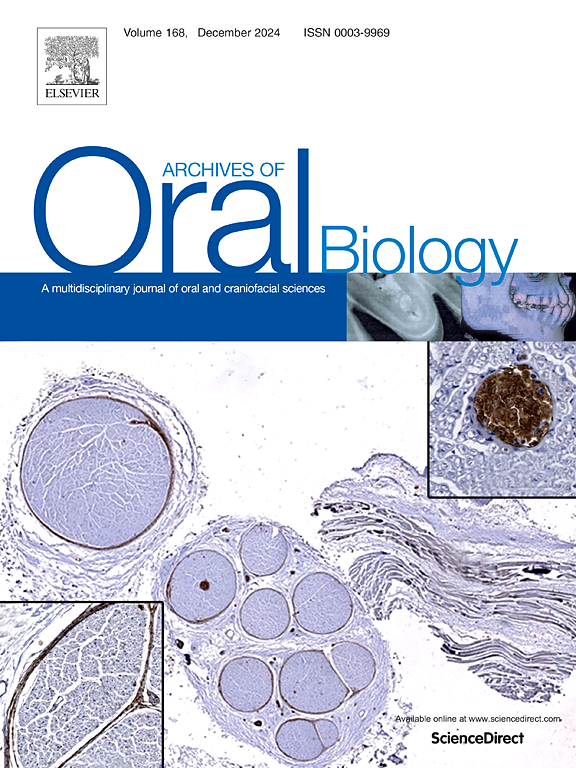Protective effect of bisabolol on glucose metabolism in salivary gland of male diabetic rats
IF 2.2
4区 医学
Q2 DENTISTRY, ORAL SURGERY & MEDICINE
引用次数: 0
Abstract
Objective
This study aimed to evaluate the effect of bisabolol treatment on the activity and expression of the main enzymes of the glycolytic pathway in the submandibular and parotid salivary glands of Streptozotocin (STZ)-induced diabetic rats.
Design
Twenty-four male Wistar rats, aged 60 days, were divided into four groups: Control, diabetic, control+Bisabolol, and diabetic+Bisabolol. A single intraperitoneal injection of Streptozotocin induced diabetes. The treated group received a daily dose of α-Bisabolol (25 mg/kg of body weight dissolved in 0.1 mL of sunflower oil) by gavage for 21 days. The untreated group received only the vehicle. All animals were euthanized 28 days after induction, and the parotid and submandibular glands were removed, frozen in liquid nitrogen, and stored at −80 °C. The expression of the main enzymes of the glycolytic pathway was analyzed through RT-qPCR. Biochemical analyses were conducted to verify Hexokinase (HK), Phosphofructokinase (PFK), Pyruvate kinase (PK), and Lactate dehydrogenase (LDH) activity. The data were statistically compared via the Student t-test and analysis of variance (ANOVA) followed by Tukey’s test, where results were considered statistically significant at p < 0.05.
Results
In general, bisabolol restored the HK and PFK activities and also restored Hexokinase 2 (Hk2), Phosphofructokinase muscle isoform (Pfkm) and Phosphofructokinase platelet isoform (Pfkp) expression in the bisabolol-treated diabetic rats. The LDH activity increased in diabetic rats with bisabolol.
Conclusion
Bisabolol treatment restored the activity and expression of key glycolytic enzymes, suggesting that it may have therapeutic potential in mitigating the salivary glands metabolic dysregulation caused by diabetes in rats.
bisabolol对雄性糖尿病大鼠唾液腺糖代谢的保护作用
目的探讨比abolol对链脲佐菌素(STZ)诱导的糖尿病大鼠颌下腺和腮腺糖酵解途径主要酶活性及表达的影响。设计雄性Wistar大鼠24只,60日龄,随机分为4组:对照组、糖尿病组、对照组+比沙洛尔组、糖尿病组+比沙洛尔组。单次腹腔注射链脲佐菌素诱导糖尿病。治疗组大鼠给予α-比abolol(25 mg/kg体重溶于0.1 mL葵花籽油中)灌胃21 d。未处理组只接受车辆。诱导28天后对所有动物实施安乐死,切除腮腺和颌下腺,液氮冷冻,- 80℃保存。通过RT-qPCR分析糖酵解途径主要酶的表达情况。生化分析验证了己糖激酶(HK)、磷酸果糖激酶(PFK)、丙酮酸激酶(PK)和乳酸脱氢酶(LDH)的活性。数据通过学生t检验和方差分析(ANOVA)进行统计比较,然后进行Tukey检验,其中p <; 0.05认为结果具有统计学意义。结果bisabolol总体上恢复了糖尿病大鼠HK和PFK的活性,并恢复了己糖激酶2 (Hk2)、磷酸果糖激酶肌肉异构体(Pfkm)和磷酸果糖激酶血小板异构体(Pfkp)的表达。服用双abolol后,糖尿病大鼠LDH活性升高。结论双abolol治疗可恢复关键糖酵解酶的活性和表达,提示其在减轻糖尿病大鼠唾液腺代谢失调方面具有治疗潜力。
本文章由计算机程序翻译,如有差异,请以英文原文为准。
求助全文
约1分钟内获得全文
求助全文
来源期刊

Archives of oral biology
医学-牙科与口腔外科
CiteScore
5.10
自引率
3.30%
发文量
177
审稿时长
26 days
期刊介绍:
Archives of Oral Biology is an international journal which aims to publish papers of the highest scientific quality in the oral and craniofacial sciences. The journal is particularly interested in research which advances knowledge in the mechanisms of craniofacial development and disease, including:
Cell and molecular biology
Molecular genetics
Immunology
Pathogenesis
Cellular microbiology
Embryology
Syndromology
Forensic dentistry
 求助内容:
求助内容: 应助结果提醒方式:
应助结果提醒方式:


